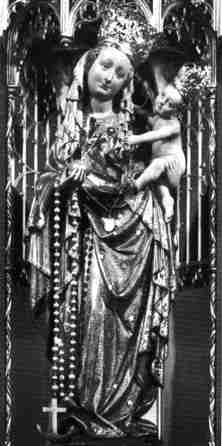History of the statue


History of the statue


No reference has been made as yet to the miracle-working statue of Our Lady, Star of the Sea, a carved wooden figure of 135 cm high, a work of intense beauty.
The statue is held in great reverence, so that the church plays a role in the worship of the Virgin which is unique in the Netherlands.
The veneration of Our Lady dates from the first days of
christianity in our area. It has been mentioned that in Maastricht the first chapel on this side of the Alps was dedicated to Her. Later this chapel became an important place of pilgrimage. It was situated on the banks of the river Maas. An old statue had been worshipped there and had been replaced later on. The guild of the tanners would have offered it and soon it had been worshipped as much as the old one, especially by the mariners who passed by the city on their ships. The name 'Star of the Sea' was added around 1700 after lives had miraculously been saved during a shipwreck. Before She was known simply as Our Lady of Maastricht.
The statue would have been made about 1420-1430 in Bohemia, and would belong, according to experts, to a special group of statues of Mary, meant for important and high class persons.
The Reformation in the 16th century with it's civil dissensions, persecutions and executions, exiled the Franciscans. The miracle-working statue first was hidden by the miller of the tanners, and after that in another convent, where the soldiers, when they found it, had been forced in a miraculous way to leave the statue alone.
In 1579, after the reconquest of Maastricht by Parma, the Franciscans could return and with them the Star of the Sea. Peace however didn't last long. In 1632 Maastricht was captured again, now by the Spanish troops under the command of Frederik Hendrik. The Franciscans had been chased away again, they took their beloved statue with them and after many wanderings they hid it in their convent at Slavante. Nobody knows of that trip, but here, where Mary is hidden, a lark sings it's song of praise every morning...
Then the French Revolution comes with it's captures and the occupation of Maastricht. Again the Franciscans had to fly and the statue was hidden in houses of citizens. In 1801 the Franciscans yield the statue to the church of St Nicholas, near to the one of Our Lady, which was claimed by the occupant. In 1837 the church of St Nicholas has been demolished, the church of Our Lady becomes the church of the parish and with great solemnity the miracle-working statue had been brought.
In 1903 the statue of the Star of the Sea had been placed in the Merode-chapel, left of the church, and where also had been made the entrance of the church. In this way the church could be closed, while the chapel could stay open all day. By this rather simple changes the Star of the Sea became Her place in the middle of the people. In this way the statue of mercy was so to speak the always burning light of the city.
In 1912 the statue had been ceremoniously crowned with the golden crowns, offered by the citizens of Maastricht. For these crowns a big number of jewels had been gathered such as many strings of real pearls and 400 diamonds, a silver rosary with anchor offered by the gratitude of a mariner, pope Pius X offered a golden star with 50 brilliants and the united Mary-congregations of the Netherlands offered a golden lilybranch set with diamonds.
The worship of the Star of the Sea was stimulated again by bishop Gulielmus Lemmens. He had an open bronzen gate made in the door of the chapel, so that the lights could be seen outside during the entire night and really no man passes by without a salute.
This is the basis for the opinion that the statue came to Maastricht when the high aged knight Nicolaas van Harlaer, first master of ceremonies of the prince-bishop of Liege, came to knock at the door of the convent of the Franciscans, to become one of them.
Soon the chapel became too small for the growing group of pilgrims. Therefore the statue had been trusted with the Franciscans in the city of Maastricht. In this time during Easter magnificent processions had been held and many prayers had been granted, testified by the many ex-voto's in the chapel.
From there it wandered yet to Vise and Tongeren, also a very old Mary-town, where the citizens brought the statue in with much respect.
The final return of the statue to Maastricht, oktober 16 1675, became a real triumphal march.
Vienna and Rotterdam, Brasil and Africa, they know the Star of the Sea of Maastricht. By the tens of thousand Her photo's with the heavenly smile are hanging on the wall in family houses, in convents, in student's rooms, in barracks, in shipcabins and in hospitalrooms.
Her chapel is never without praying people, as long as it is open. And when in the evenings the open gate is moved into the door, one can see people until very late in the evening, standing or kneeling on the pavement, who are asking, thanking and worshipping their heavenly Mother.
The Fraternity of Our Lady, Star of the Sea, an association which has existed for many centuries, attends to the statue and to its veneration.
August 15 is the main feast for the entire city and the wide surroundings.
The former maire of Maastricht, Mr Baron Michiels van Kessenich, stated: "Who knows the sorrows of a family without a mother, knows how rich we are with Mother Mary in our house of God."
